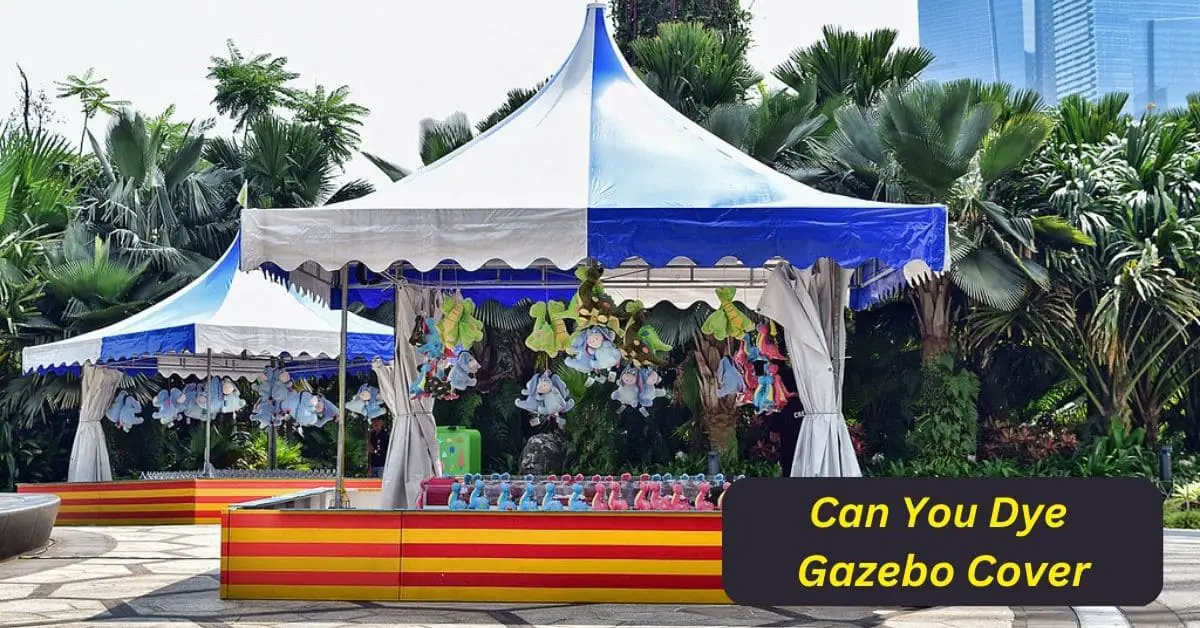Gazebo covers are a popular choice for providing shade and shelter in outdoor spaces, but they can become faded or stained over time. You may consider dyeing your gazebo cover to restore its color or give it a new look.
However, before you proceed with dyeing, consider some things.
Firstly, knowing what type of material your gazebo cover is made of is essential, as not all materials can be successfully dyed.
Additionally, the dyeing process can be tricky and requires careful attention to detail, as you want to avoid damaging or ruining the cover.
In this article, we’ll explore the different materials used for gazebo covers, the pros and cons of dyeing, and some tips for successfully dyeing your gazebo cover.
So, let’s discover if dyeing your gazebo cover is a feasible option for you.
Can you dye Gazebo cover: Yes, you can dye a gazebo cover, but it is important to choose the right type of dye and follow the manufacturer’s instructions carefully. It is also important to note that dyeing may affect the integrity and durability of the fabric, so it is recommended to test a small, inconspicuous area first and proceed with caution.
Can you dye Gazebo cover? Tips on Dyeing
A gazebo is a nice place to relax, but the cover or canopy can get worn out easily from the sun, wind, rain, and snow.
You can make it look better again by dyeing it or using paint or stains. This can be a cheaper way to give your gazebo a new look.
However, how you touch up your gazebo depends on its type. Gazebos that can be taken down or have a hardtop can have their covers dyed.
But gazebos built permanently with timber and metal should use paint or stains instead.
How to Dye Gazebo Covers?
Dyeing gazebo covers, and awning canopies can help them last longer and look better. You can do it using the same method for covers and canopies. However, some covers cannot be dyed, so use the right kind of dye for cover materials.
There are different ways to dye a gazebo cover, but we’ll focus on doing it manually. You’ll need some basic home supplies, and we’ll go through the steps of dyeing it manually, washing it with a machine, and then washing it again to finish.
Materials Needed for Dyeing a Gazebo Cover
To dye a gazebo cover, you will need the following materials:
Dye: You must choose a dye suitable for your gazebo cover’s material. Fabric, acrylic, and polyester dyes are available in various colors.
Large container: You will need a large container to hold the gazebo cover and the dye. The container should be made of a non-reactive material such as plastic or stainless steel.
Water: You must have enough water to submerge the gazebo cover in the dye. The amount of water needed will depend on the size of your container.

Salt or vinegar: Some dyes require the addition of salt or vinegar to help set the color.
Check the dye manufacturer’s instructions to see if this is necessary.
Protective gloves: Dyes can stain your skin, so it is important to wear protective gloves while handling the dye.
Stirring utensil: You will need a stirring utensil to ensure that the dye is evenly distributed throughout the container.
Gazebo cover: Of course, you will need the gazebo cover that you want to dye. Be sure to choose a cover that is made of a dyeable material.
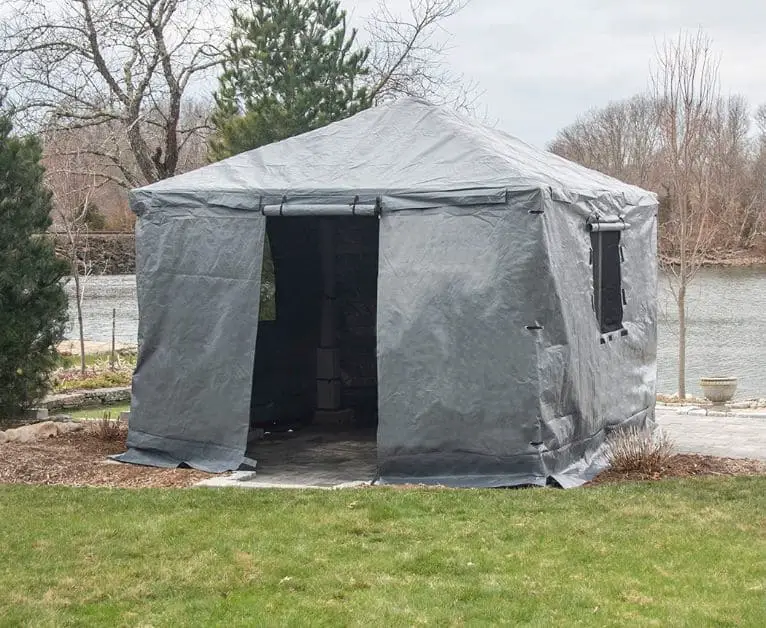
Washing detergent: After dyeing the gazebo cover, you must wash it with mild detergent to remove any excess dye.
Washing machine or basin: You will need a washing machine or basin to wash the gazebo cover.
The washing machine or basin size should be large enough to accommodate the gazebo cover.
Clothesline or dryer: After washing the gazebo cover, hang it on a clothesline or dry it in a dryer. Be sure to follow the manufacturer’s instructions for drying the cover.
Types of Gazebo Cover
A gazebo cover is an important part of a gazebo, providing protection from the sun and rain. There are different types of gazebo covers available, each with its unique features and benefits. We will discuss the four most common types of gazebo covers.
Fabric Gazebo Cover
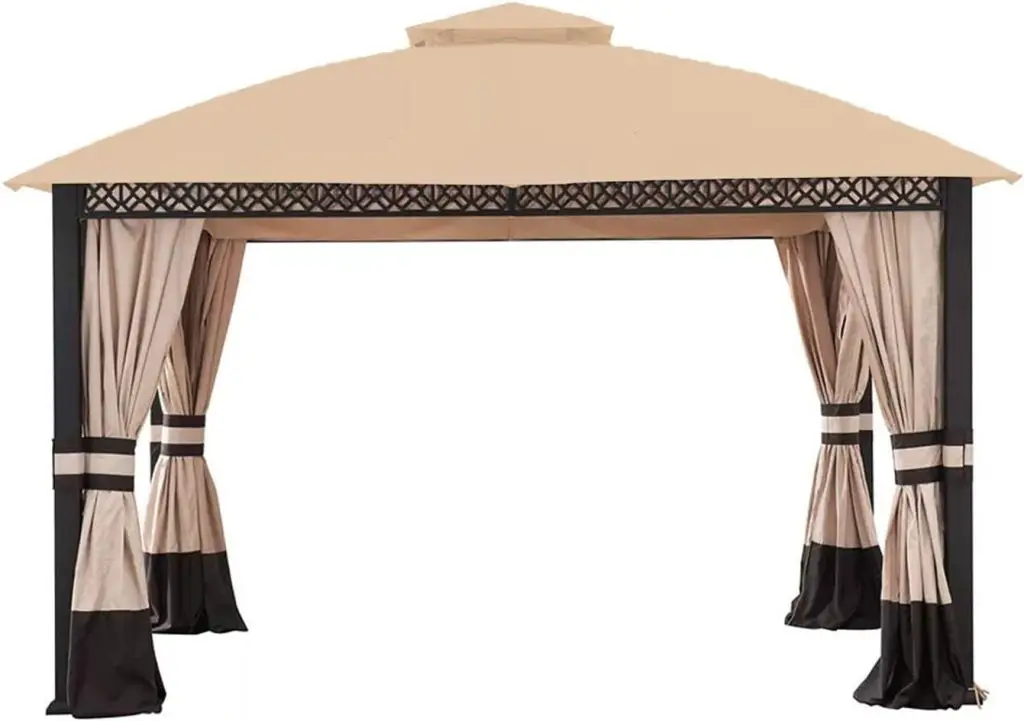
Fabric gazebo covers are popular due to their versatility, durability, and appearance. They can be made from cotton, canvas, or polyester and come in various colors and designs.
Fabric covers are easy to remove and wash, making them low-maintenance. However, they may be prone to fading and mildew over time.
Vinyl Gazebo Cover
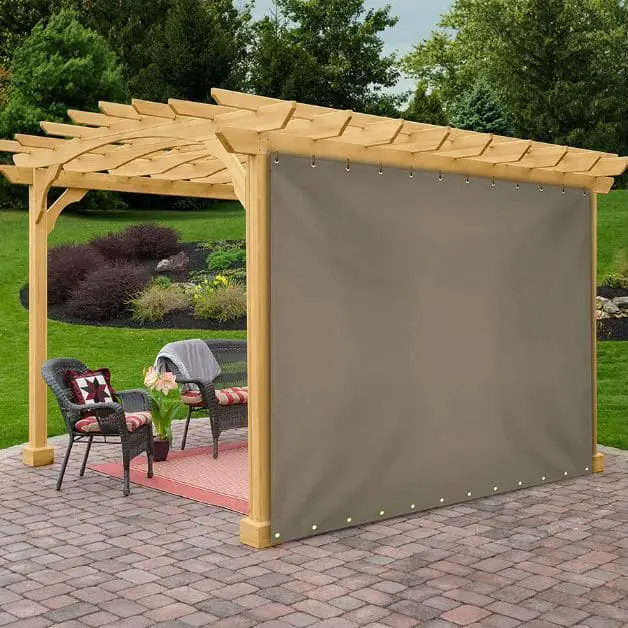
Vinyl gazebo covers are made from PVC, a synthetic material known for resisting weather and UV damage.
They are durable and easy to clean, making them popular for areas with harsh weather conditions. However, they may not be as aesthetically pleasing as fabric covers.
Polyester Gazebo Cover
Polyester gazebo covers are made from a durable synthetic fabric that resists weather and UV damage.
They come in various colors and designs and are easy to clean and maintain. However, they may not be as long-lasting as vinyl covers and can fade over time.
Mesh Gazebo Cover
Mesh gazebo covers are made from breathable fabric that allows air to circulate freely while still providing protection from the sun and rain.
They are ideal for use in hot and humid environments, as they help to reduce heat buildup inside the gazebo.
However, they may not provide as much protection from the rain as other types of covers.
When choosing a gazebo cover, it’s important to consider factors such as durability, maintenance, appearance, and functionality. Each type of cover has its own unique advantages and disadvantages, so it’s essential to choose the one that best fits your needs and requirements.
Types of Dye
There are many types of dyes available for various materials, but the four types you listed are:
Fabric Dye
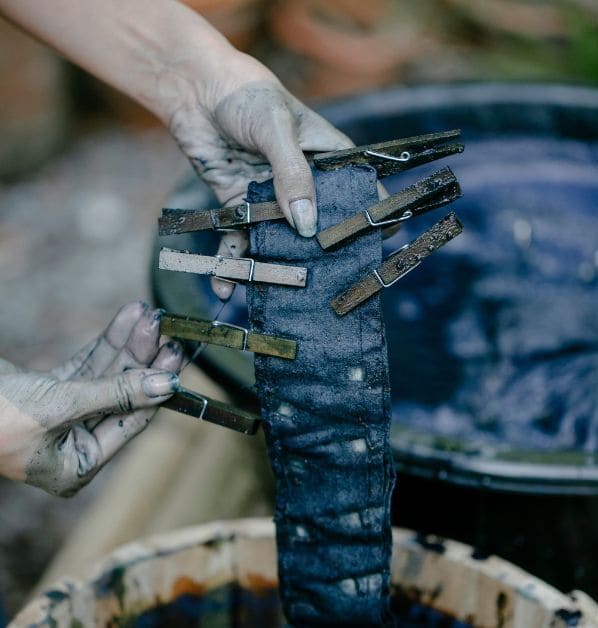
These dyes are designed for natural fibers such as cotton, linen, silk, and wool.
They can be used in a variety of ways, such as soaking the fabric in a dye bath, applying the dye with a brush, or using a tie-dye technique.
Fabric dyes come in many colors and can produce vivid, long-lasting results.
Acrylic Dye
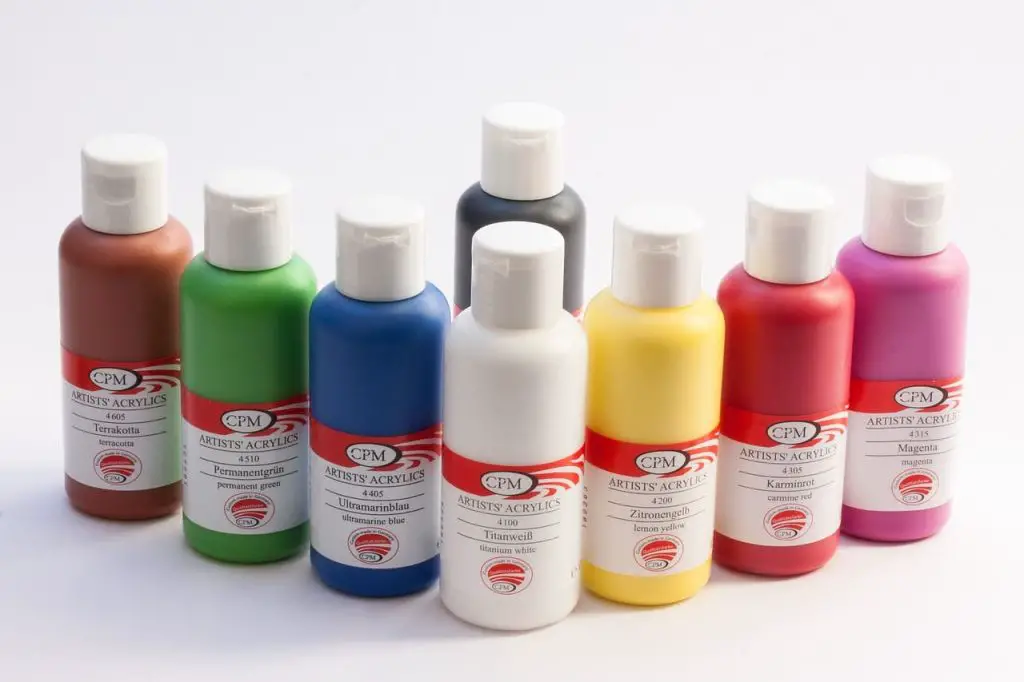
Acrylic dyes are specifically formulated for synthetic fibers such as polyester, nylon, and acrylic.
They are often used to dye clothing, upholstery, and other household items.
Acrylic dyes are heat-set, meaning they need to be ironed or put in a clothes dryer to set the color.
Vinyl Dye
Vinyl dye colors vinyl and plastic materials, such as car seats, boat covers, and outdoor furniture. This type of dye is formulated to bond with the material’s surface, creating a long-lasting, durable finish.
Polyester Dye
Polyester dyes are formulated explicitly for polyester fabrics. They can be used to dye clothing, bedding, and other items made from polyester. These dyes often require high heat to set the color, so they are typically used with a washing machine or a stovetop dyeing method.
Steps in Dyeing Gazebo Cover
Dyeing a gazebo cover can be a great way to refresh the look of your outdoor space without replacing the entire pavilion.
However, dyeing a gazebo cover can be tricky, as not all can be successfully dyed. If you’re looking to dye your gazebo cover, here are the steps to follow:
Preparing the Gazebo Cover
Check the care label: Before you start the dyeing process, it is important to check the care label of the gazebo cover to ensure that it is safe to dye. Some gazebo covers may be labeled as “dry clean only” or “do not bleach”, meaning they may not be suitable for dyeing.
Clean the gazebo cover: Make sure that the gazebo cover is clean before dyeing. This will help the dye to adhere evenly to the fabric. You can wash the gazebo cover using a gentle detergent by hand or in the washing machine.
Rinse the gazebo cover: After washing, rinse the gazebo cover thoroughly to remove any soap residue. Ensure all the soap is rinsed out, as any remaining soap can affect the dyeing process.
Dry the gazebo cover: Allow it to air dry or put it in a low heat setting in the dryer. Ensure the gazebo cover is completely dry before proceeding to the next step.
Preparing the Dye
Choose the right dye: Choose a dye appropriate for the fabric the gazebo cover is made of. For example, choose a fabric dye designed for cotton if the gazebo cover is made of cotton.
Mix the dye: Follow the instructions on the dye package to mix the dye. Make sure to wear gloves and protect your work area from any spills.
Add salt or vinegar: Depending on the dye you are using, you may need to add salt or vinegar to the dye bath. This will help the dye to adhere to the fabric and create a more even color.
Dyeing the Gazebo Cover
Soak the gazebo cover: Fill a large container with hot water and add the dye mixture. Stir the water to make sure that the dye is evenly distributed. Then, immerse the gazebo cover in the dye bath, completely submerging it.
Stir the gazebo cover: Use a spoon or tongs to stir the gazebo cover in the dye bath. This will help distribute the dye evenly and ensure the color is consistent.
Check the color: Check the color of the gazebo cover after a few minutes of soaking. If the color is not dark enough, leave the gazebo cover in the dye bath longer.
Rinse the gazebo cover: Once the desired color is achieved, remove it from the dye bath and rinse it thoroughly in cold water. This will help to remove any excess dye and prevent the color from fading.
Washing and Drying the Gazebo Cover
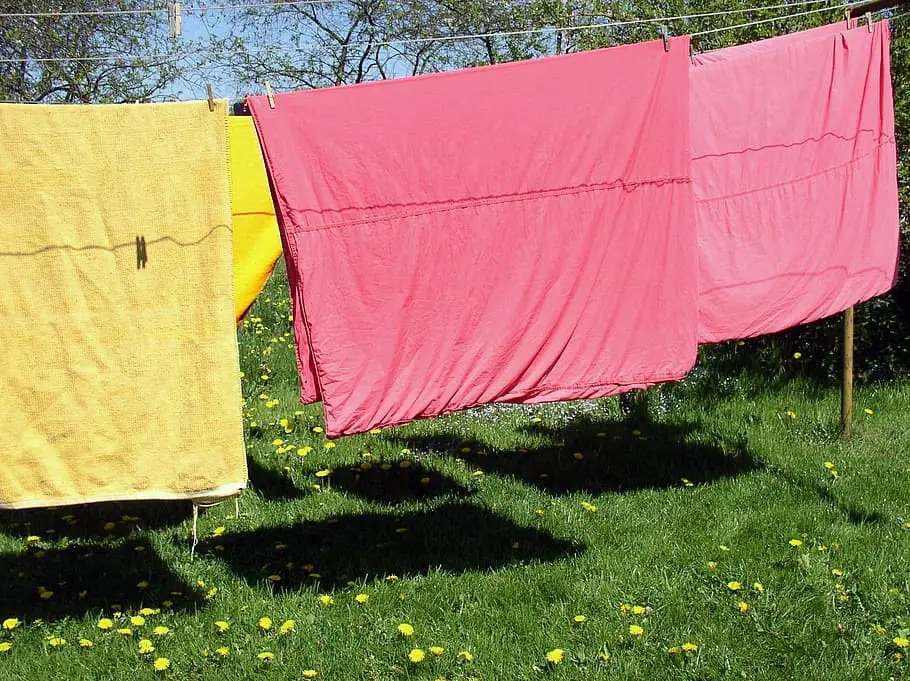
Wash the gazebo cover: Wash the gazebo cover in cold water with mild detergent. This will help remove any remaining dye and ensure the color is set.
Rinse the gazebo cover: Rinse the gazebo cover thoroughly in cold water to remove any remaining soap.
Dry the gazebo cover: Air dry it or put it in a low heat setting in the dryer. Make sure that the gazebo cover is completely dry before using it again.
Tips for Dyeing Gazebo Cover
Dyeing a gazebo cover can be a fun and rewarding DIY project. It allows you to update the look of your outdoor space without replacing the entire pavilion.
However, before you dive into dyeing your gazebo cover, it’s important to remember some tips to ensure the best results. Here are some tips for dyeing your gazebo cover:
Wear protective gloves
Dyeing a gazebo cover can be messy, and the dye can stain your hands. It’s important to wear protective gloves to prevent the dye from coming into contact with your skin. You can use latex or rubber gloves, depending on your preference.
Follow the dye manufacturer’s instructions.
Different types of dye require different methods of application. It’s essential to read and follow the dye manufacturer’s instructions carefully. This will ensure you apply the dye correctly and achieve the desired results.
Test the dye on a small portion of the gazebo cover first
Before dyeing the entire gazebo cover, it’s important to test the dye on a small portion. This will give you an idea of how the dye will look and how well it will absorb into the material.
It’s best to choose an inconspicuous area of the cover for the test, such as the underside of the canopy. This will allow you to see how the color will turn out without risking ruining the entire cover.
Be careful not to dye surrounding areas.
When dyeing the gazebo cover, be careful not to spill the dye onto any surrounding areas, such as your patio or deck. The dye can stain surfaces and be difficult to remove. To prevent this, lay down a drop cloth or plastic sheeting underneath the gazebo cover to catch any spills.
Use enough dye
It’s important to use enough dye to ensure the color is evenly distributed across the gazebo cover. The color may be uneven or splotchy if you don’t use enough dye.
Be sure to follow the dye manufacturer’s instructions for the recommended amount of dye to use.
Rinse the cover thoroughly.
After dyeing the gazebo cover, it’s important to rinse it thoroughly to remove any excess dye. This will help prevent the dye from bleeding or rubbing off onto other surfaces. You can rinse the cover with a hose or in a tub of cold water.
Allow the cover to dry completely.
Once you’ve rinsed the cover, allow it to dry completely before using it again. Hanging the cover up to dry in the sun is a good option, as this can help the color set and prevent the dye from bleeding. Be sure to check the manufacturer’s instructions for specific drying recommendations.
Consider using a fixative.
To ensure the dye color is long-lasting, consider using a fabric fixative. This product helps the dye adhere to the fabric fibers and can prevent the color from fading or bleeding. Be sure to follow the fixative manufacturer’s instructions carefully.
Avoid dyeing on a windy day.
Dyeing a gazebo cover on a windy day can be difficult, as the dye may blow around and create a mess. Choosing a calm day with little to no wind is best for the best results.
Care And Maintenance
Once you have dyed your gazebo cover, it is important to properly maintain and care for it to ensure it lasts as long as possible. Here are some tips on how to maintain and care for your newly dyed gazebo cover:
Regular cleaning: Regular cleaning is essential to keep your gazebo cover looking its best. Use a soft brush or cloth to remove dirt or debris from the cover. You can also use a mild detergent and warm water to clean the cover, but rinse thoroughly to remove any residue.
Proper storage: When your gazebo is not in use, it is important to store the cover properly. Ensure the cover is completely dry before storing it to prevent mold and mildew growth. Store the cover in a dry, cool place away from direct sunlight.
Avoid harsh chemicals: Harsh chemicals such as bleach or ammonia can damage the dye on your gazebo cover. Avoid using these types of chemicals when cleaning your cover.
Protect from sun exposure: Prolonged exposure to direct sunlight can fade the dye on your gazebo cover. To protect your cover, consider using a gazebo cover with UV protection or move your gazebo to a shaded area when not in use.
Repair any damage: If you notice any tears or holes in your gazebo cover, it is essential to repair them as soon as possible to prevent further damage.
Use a patch kit specifically designed for the material of your cover or consider taking it to a professional for repair.
By following these tips, you can ensure your newly dyed gazebo cover remains in excellent condition for years to come.
Proper maintenance and care are key to extending the life of your gazebo cover and protecting your investment.
Which is better for a gazebo, painting or staining?
When protecting your gazebo, you have two options: painting or staining. Staining is good for timber because it goes deep into the wood and keeps moisture out.
You can add multiple layers and be confident that the first layer seals the timber completely.
Paint can also work, but it’s usually used as an extra layer on top of the timber. Paint doesn’t soak into the wood, so moisture can get in if there are cracks or damaged areas.
You can prime the timber before painting it to make it more durable, but that’s not always enough. Also, stains look more natural than paints, which can be any color you want.
Which option lasts longer, paint or stain for outdoor use?
The time paint or stain lasts depends on how well you prepare the wood before applying it. Paint can last up to 10 years if you use a primer and apply 2-3 coats. Staining must be reapplied every 2-3 years to keep it strong, but this helps your gazebo last longer.
Preparing the wood well makes it easier to apply and keeps moisture out.
FAQs
Q.1 Can you use paint on a fabric gazebo?
Yes, you can use paint on most outdoor fabrics, such as canopies, awnings, umbrellas, cushions, and even outdoor rugs. It is a good way to update and refresh them.
Q.2 Is it possible to apply paint to a gazebo canopy?
Painting a gazebo canopy is a good way to protect the wood from rain, wind, and sunlight. This will help your gazebo to last longer and look better. Before painting your gazebo, you should learn which paint and varnish is suitable for outdoor use. This will help to protect it from natural elements and give it a nice, finished look.
Q.3 How long will the dye last on a gazebo cover?
The durability of the dye on a gazebo cover will depend on various factors, such as the quality of the dye used, the material of the gazebo cover, and exposure to sunlight and weather conditions.
Q.4 Will spray paint hold up outside?
Use spray paint designed specifically for outdoor use to ensure the paint lasts. This paint is made to withstand exposure to weather elements such as sun rays, rain, and humidity. If you use spray paint meant only for indoor surfaces, it won’t last long outside. Check the label for spray paint suitable for indoor and outdoor projects.
Q.5 Will dyeing a gazebo cover affect its waterproofing or UV protection?
Dyeing a gazebo cover can potentially affect its waterproofing and UV protection. It is important to choose a dye designed for outdoor fabrics and follow the manufacturer’s instructions carefully.
conclusion
In conclusion, dyeing a gazebo cover can be a cost-effective and creative way to spruce up your outdoor space.
With the right materials and techniques, you can easily transform a faded or outdated gazebo cover into a fresh, vibrant one that matches your style.
Before dying, it’s important to carefully select the type of gazebo cover and dye that will work best for your needs.
Polyester and nylon covers are typically the most dyeable, while natural materials like cotton may require a different type of dye.
To dye your gazebo cover, you’ll need to prepare the cover and the dye solution and then apply the dye evenly to the fabric.
After allowing the dye to set for the recommended time, you must rinse and wash the cover to remove any excess dye.
Taking care of your newly-dyed gazebo cover is also essential to ensure it lasts as long as possible. Avoid harsh chemicals and excessive sun exposure, and consider storing the cover indoors during the off-season to prevent fading or damage.
Dying a gazebo cover is a fun and easy DIY project that can add color and personality to your outdoor space.
With these step-by-step instructions and tips, you can create a beautiful, custom gazebo cover you’ll love for years.
After reading this detailed guide on dyeing a gazebo cover, we hope you understand the process well. If you have any questions, please don’t hesitate to comment below.

